raumer
Part of things
 
Posts: 138 
|
|
|
|
I'm finally getting round to doing a thread on my retro vehicles a well as my girlfriends. As we've got a few and they are quite wide ranging in size I've decided rather than doing a thread on each I'll do a thread for the light ones and a thread for the heavies. Will also make my life a lot easier as we are working on multiples at the same time. Due to having moved around the country in the last two years for new jobs and still hunting for a suitable property to store them all on (as well as needing to find a job at the moment) they are scattered around the country. In 2018 we were in Gloucestershire, then new job in Coventry so moved up to Leicestershire. Then job loss and end of rental so back to Gloucestershire as most of our big vehicles are down here. So this thread will be for work we do on the light vehicles. We'll start with an intro for each of them. 1960 Landrover Series 2 SWB owned for over 20 years 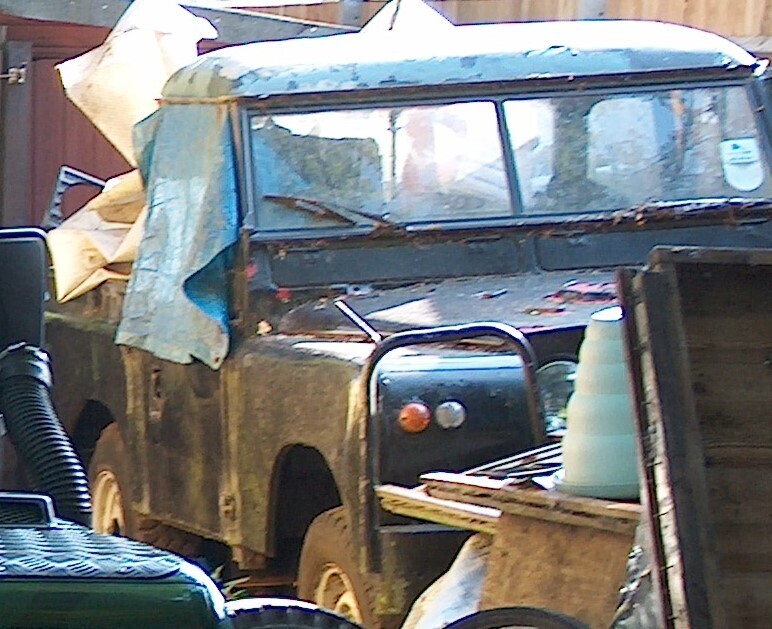 My first car and the one that taught me a lot about driving. Nothing like a 2.25 petrol series landie to teach you about maintaining momentum, racing lines and how to change gear! Used as my only car before going to University. Used for transporting mountain bikes and all sorts of other things. Then replaced by a Hillman Imp which did a few more mpg. Then brought back out and driven for a couple of years. It has been sat in my parents garden ever since. In need of lots of work - probably new chassis, engine rebuild, bulkhead etc... But it's at the bottom of the list and will be used for any hard to get parts for the 1962 Landrover prototype. It's not very original and we think was used as a recovery truck so will always be a bitsa. Might be bottom of the list for restoration but near the top for ones we won't get rid of. 1962 Landrover Series 2a LWB prototype owned for about 9 years 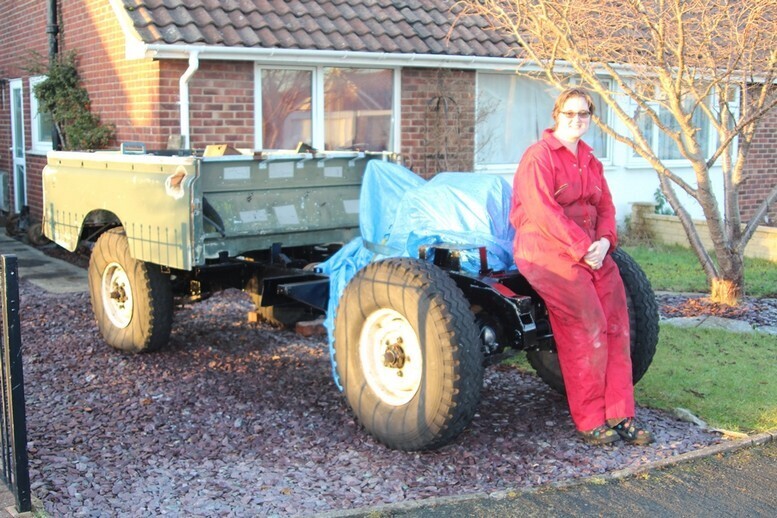 My girlfriends pride and joy. Possibly the worst condition Landrover I've come across. Every bit needs rebuilding! Example being steps worn in to every single leaf of the leaf springs. It has had a very hard life. Currently a rolling chassis with rebuilt suspension and axles. Also on a new chassis for first build. Bulkhead and front panel off with an expert being repaired. The rolling chasis with engine & gearbox fitted but not rebuilt is at my parents, remaining parts in Gloucestershire. This one we are very picky with and everything has to be as original. It's going to take a while hunting for parts and rebuilding it but it will be worth it. 1983 Landrover 110 CSW owned for over ten years 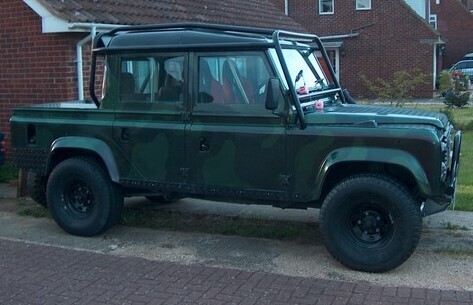 As we got it. 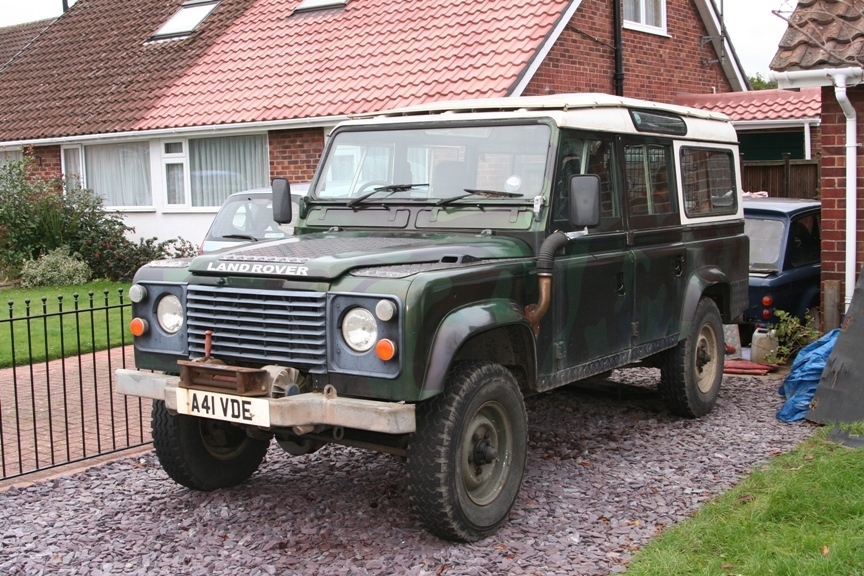 As it is now. This has been the work horse ever since it arrived. Has had many changes and been used & abused. Bought as a double cab with a very fancy flip and glitter camo paint job. Looked stunning and with lots of carpet stuck on the inside. But underneath the shiny bits a lot of bits that either hadn't been done properly or just not done. For instance bottom of the passenger doors rotted out, roll cage badly mounted, fuel system incorrectly plumbed etc... but on a new chassis. When we bought it it was relatively cheap and it is a Landrover so at least parts are cheap. Plus it has a 200tdi engine and unusually gearbox out of a discovery, one of the toughest engines around. Highlights of it's life with us - freezing the engine as it came with no antifreeze in it, heat seized the engine due to temp guage not working and a broken hose. Ended up pouring cold water in to it as it was blocking a gateway with accompanying crackling sounds. Then keeping it topped up as it was the sole tow vehicle for moving most of our stuff to a new storage area over a weekend. Ended up having to replace the radiator immediately and then the head gasket a week later. Also has done a lot of towing, picking up vehicles and parts for us and friends. Including a couple of house moves. Pulled a sunken boat out of canal as part of the canal restoration work, also moved a dumper based winch vehicle for the same. Off the road for two years due to clutch breaking and house move. Now has replacement engine due to the old one being tired. Rewired along with rear floor and seat box area being replaced during lockdown. Then mot'd and back on the road in time for us moving to Cam, Gloucestershire. Photos show how it has changed visually as we have owned her. From double cab with roll cage and wide tyres to county station wagon with sensible tyres. Has had all the seats replaced along with lots of other bits along the way. Problematic for a lot of parts as it is the first year of 110 production so has some series bits, some general 110 bits and some bits only fitted for the first 2 years of production. 1985 Landrover 110 Ex-military 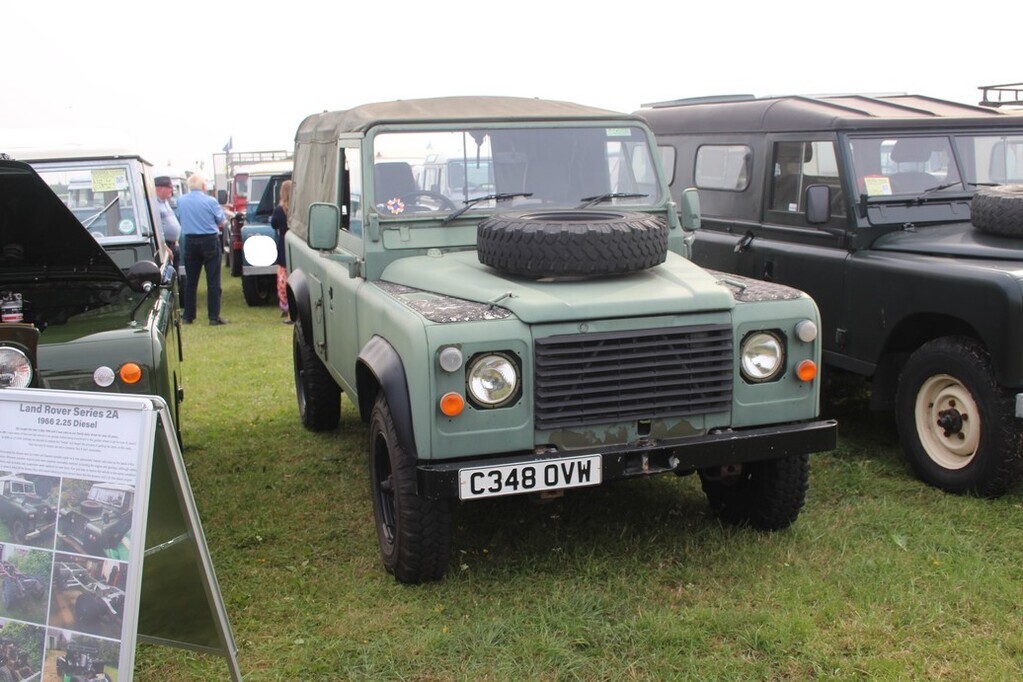 My girlfriends other Landrover. Owned for a bit over two years. Used to be owned by a friend of ours and we bought it when we moved from Gloucestershire up to Leicestershire. Fun bit is that is now on the driveway of our rented house about half a mile from the house of our friend we bought it from. It is original and has the 2.5 N/A diesel with big bore exhaust - dependable but it is slow! Plus it has an LT77 gearbox - hated by me but my girlfriend and everyone else who drives it seems to like it. During lockdown it has had the side lockers rebuilt and a few other odd jobs. It was part of a military upgrade program (Tithonus) which included the fitting of a roll over hoop and the wolf wheels. Used for load lugging including camping gear, workshop equipment, parts of all the other vehicles and my girlfriends vintage bicycles. Decent size load area and 1 ton carrying capacity along with Landrover off road ability makes a very useful tool. Other light vehicles are all 2 or 3 wheeled. Including a BSA bantam, 1890's tricycle, multiple tradesman's bicycles and my mountain bikes. Previous light classic vehicles have included, Hillman Imp's, Clan Crusader ex-works rally car (400kg ready to run in hillclimb trim), Modsports Davrian (one of the only race cars I've ever come across that have done a 100% season, winning it's class every time out), Hillman Husky's (Imp based), Hillman Imp 850 race car completely original and heavily drilled out. All of those have now gone as we changed to the larger vehicles. May put up photos of some of them during the thread if anyone wants. During this thread the 1962 and 1983 Landrovers will be the most likely to appear. |
| |
Mine: 1938 Scammell Pioneer R100, 1944 Scammell Pioneer SV2/S, 1959 Kraz 255b tractor unit, 1960 Unipower Industrial ballast tractor, 1960 88 Landrover Series 2 SWB, 1983 110 Landrover CSW
Look after:
1935 Scammell Rigid 6, 1951 Scammell Scarab, 1961 Landrover Prototype, 1985 Landrover 110
|
|
|
|
|
|
|
|
|
|
Very interesting reading other people's state of 'Landroveritis', which you will know that there is no cure for.
Having got to the last paragraph, I came upon the comment "Hillman Husky's (Imp based)". I thought that can't be right; as a family the first car my parents bought in 1962, was a 'Commer Cob', first registered in 1961. This was the less refined version of the infamous 'Hillman Husky' and was most certainly not Imp-based.
Right methinks, what's this bloke on about? So Internet Search here we come; only to discover that there was an Imp-based vehicle, which was also called the 'Hillman Husky'. Good old ROOTES Group and their badge engineering.
So high-jacking your thread, here is what I discovered.
Original Hillman Husky ("Mark 1")
The first (or "Mark 1") Hillman Husky, introduced in 1954, was a small estate car based on the contemporary "Mark VIII" Hillman Minx.
The two-door Husky entered the range alongside an existing Minx estate car, which had a 9-inch (230 mm) longer wheelbase.
The Husky was not a hatchback, having instead a single side-hinged rear door. While the new Mark VIII Minx De-Luxe saloon, convertible and "Californian" hardtop used a new OHV 1,390 cc (85 cu in) engine, the Husky continued to use the older 1,265 cc (77.2 cu in) 35 bhp (26 kW) side-valve engine with single Zenith carburettor which it shared with the Minx "Special" saloon and estate.
Unlike the Minx with its column change, the gear lever for the Husky was floor mounted.
There were individual seats in front and a bench seat in the rear which would fold flat to increase load area. The trim material was leathercloth.
Both the heater and radio were optional extras.
The car was available in blue, grey, green or sand paint (1954 colours).
42,000 of this Husky were sold until the model was replaced in 1958 (a year after the "parent" Minx was itself replaced).
The Motor magazine tested a Husky in 1954 and found it to have a top speed of 65 mph (105 km/h) and acceleration from 0-50 mph (80 km/h) in 24.3 seconds. A fuel consumption of 33.4 miles per imperial gallon was recorded. The test car cost £564 including taxes.
"Audax Series" Hillman Husky Series I.
In 1958 the new "Series I" Husky was introduced. It followed the same formula as its predecessor, but was based on the new "Audax" or "Series" Hillman Minx.
This time the engine was the new Minx's 1390 cc overhead-valve unit but de-rated to an output of 51 hp.
As before, there was also a four-door "Minx estate", and the Husky had two doors (plus the side-hinged rear door) and a shorter wheelbase (by 8 inches (200 mm)). It was, however, 2 inches (51 mm) longer than its predecessor.
Again, Commer sold a panel van version of the same vehicle as the ‘Commer Cob’.
Series II
A "Series II" Husky followed in 1960 with a four-speed gearbox, slightly lowered roof, a deeper windscreen, and altered seats. The engine compression ratio was raised to 8:1 and the carburettor changed to a Zenith 30 VIG type.
Testing the Husky in 1960, The Motor magazine recorded a top speed of 73.4 mph, acceleration from 0-60 mph of 26.9 seconds and a fuel consumption of 30.8 miles per imperial gallon; the test car cost £674 including taxes.
Series III
The final iteration of the "Audax" Hillman Husky, the "Series III", made its debut in 1963, along with a face-lift for the whole Minx range (and its badge-engineered derivatives).
The face-lift bodywork changes were applied to the Husky, but the reduction in wheel size from 15-inch (380 mm) to 13-inch (330 mm), which was applied to the saloons, was not applied to the Husky in order to maintain its ground clearance.
In addition, whilst the contemporary Series V Minx got front disc brakes, the Husky continued with four-wheel drum brakes.
The 1390 cc engine continued to be used in most markets, however for the USA, the Husky adopted the 1,592 cc engine used in the contemporary Minx Series V.
From 1964 the Husky gained an all-synchromesh gearbox and changes to the clutch and suspension. Production of the Series III ended in 1965.
Hillman Imp van derivative - Hillman Husky (Imp based)
Predecessor Hillman Husky
Successor None
No further Huskies were made until a new model based on the Hillman Imp appeared in April 1967.
This new Husky shared the Imp's rear-mounted 875 cc overhead camshaft engine, and had slightly better performance than the Imp, being approximately 330 lb (150 kg) lighter.
The same engine was also adopted by the Bond 875.
Like the earlier van version, the "Imp estate" was based on the two-door car, with the roof raised by 4 inches (100 mm) to provide a large carrying space above the engine bay, giving the car a square boxy look.
The unusually flat roof was reinforced with stiffening ribs and supported on the inside of the vehicle with "synthetic foam noise-deadening material".
When compared to the Commer badged panel van from which it derived, the Husky body also had extra stiffening at the rear window apertures.
Loading access was by a vertical top-hinged rear tailgate with the bottom of the opening level with the floor, making it easy to load without stooping down.
Sliding windows gave ventilation and a view out from the rear bench seat.
The top part of the back-seat squab folded forward forming a useful horizontal loading platform with a ribbed rubber surface, and 50 cubic feet of capacity.
To take the increased load, this was the first Hillman derivative to have radial-ply tyres.
It also had uprated rear shock absorbers and rear springs were fitted along with a strengthened rear suspension. These gave the Husky sportier handling that the standard Imp, and looked surprising when this tall vehicle went quickly round a corner with very little roll.
Once more Commer sold a commercial version of the same car, the van version which was launched in 1965 and had the engine in low-compression form.
|
| |
|
|
raumer
Part of things
 
Posts: 138 
|
|
|
|
|
The imp based Husky had superb load carrying ability. Including the ability to take milk churns upright. Also helped by having a full width door.
|
| |
Mine: 1938 Scammell Pioneer R100, 1944 Scammell Pioneer SV2/S, 1959 Kraz 255b tractor unit, 1960 Unipower Industrial ballast tractor, 1960 88 Landrover Series 2 SWB, 1983 110 Landrover CSW
Look after:
1935 Scammell Rigid 6, 1951 Scammell Scarab, 1961 Landrover Prototype, 1985 Landrover 110
|
|
dazcapri
North East
Enter your message here...
Posts: 1,061
|
|
|
|
|
|
| |
Mk3 Capri LS
|
|
|
|
|
|
|
|
I'm going to be watching this with interest, particularly learning a bit more about the prototype, currently rebuilding a prototype Land Rover myself. So many vehicles, your worse than me and looking forward to the heavy metal post.
|
| |
1954 Land Rover 107 Station Wagon
1955 Land Rover 86 Utility
1956 Land Rover 107 Pick Up
1986 2CV
1947 Ransomes Crawler Tractor
2001 C15 Citroen Van
2017 VW crafter
|
|
raumer
Part of things
 
Posts: 138 
|
|
|
|
|
The joy of working on prototypes. I have been following your thread with interest and can sympathise with some of the issues. Out of our vehicles we've got one prototype, 2 earliest known survivors, 2 start of production and a one off. All have similar parts issues.
For the prototype Landrover it takes some thought and you need to remember what they had available when they were building it. On ours some parts are from later models and some is mix & match. The chassis is a mix of military and civilian parts - easy to do at the time. Ours was built to take 9.00R16 tyres which only the military ones had at the time and it was just before the forward control came out. Ours like yours spent some time as a Landrover hack so a lot of mods done by them.
|
| |
Mine: 1938 Scammell Pioneer R100, 1944 Scammell Pioneer SV2/S, 1959 Kraz 255b tractor unit, 1960 Unipower Industrial ballast tractor, 1960 88 Landrover Series 2 SWB, 1983 110 Landrover CSW
Look after:
1935 Scammell Rigid 6, 1951 Scammell Scarab, 1961 Landrover Prototype, 1985 Landrover 110
|
|
|
|
|
|
|
For the prototype Landrover it takes some thought and you need to remember what they had available when they were building it. Spot on. There has been a lot of head scratching and working out dates of changes via the parts book, to try and establish what should have been there . A lot of small changes happened across the model range, just after mine was built. |
| |
1954 Land Rover 107 Station Wagon
1955 Land Rover 86 Utility
1956 Land Rover 107 Pick Up
1986 2CV
1947 Ransomes Crawler Tractor
2001 C15 Citroen Van
2017 VW crafter
|
|
|
|
|
|
|
|
I do love Land Rovers and would love to own one! Thread bookmarked 😎
|
| |
|
|
|
|
|
|
|
I do love Land Rovers and would love to own one! It's a very long and very slippery slope! Also bookmarked!. |
| |
|
|
|
|
|
Jan 12, 2021 21:15:32 GMT
|
|
Parallel paths although I've yet to get into the large commercials , but do have a T20 tucked away ! Bookmarked
|
| |
retired with too many projects!
|
|
|
|
raumer
Part of things
 
Posts: 138 
|
|
Jan 13, 2021 14:38:44 GMT
|
|
Good to see you here Keith. I'm sure I can drag you in to the large commercial world at some point!
Ed
|
| |
Mine: 1938 Scammell Pioneer R100, 1944 Scammell Pioneer SV2/S, 1959 Kraz 255b tractor unit, 1960 Unipower Industrial ballast tractor, 1960 88 Landrover Series 2 SWB, 1983 110 Landrover CSW
Look after:
1935 Scammell Rigid 6, 1951 Scammell Scarab, 1961 Landrover Prototype, 1985 Landrover 110
|
|
raumer
Part of things
 
Posts: 138 
|
|
Mar 26, 2021 20:45:43 GMT
|
Time to add some history on my 110 CSW. As mentioned earlier it looked shiny and very nice when we got it. But the nice paint job did hide a lot. Below I'll run through the major changes we made and what difference it made. Starting from this: 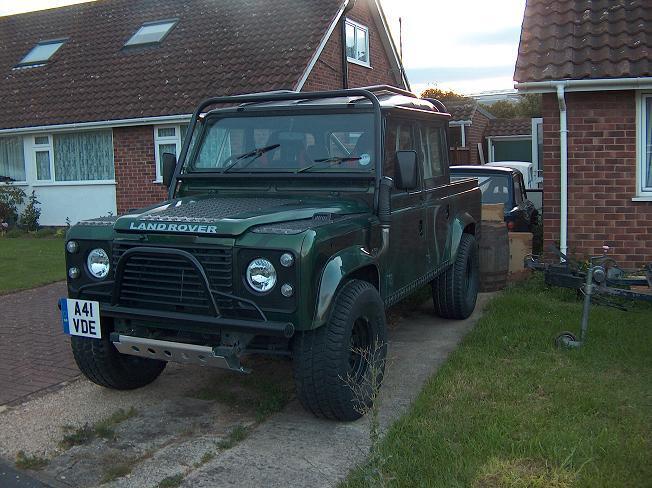  Double cab with modified roof, lots of chequer plate, roll cage, wide wheels with 33" tyres, tubular bumper, bucket seats, fully carpeted inside. It stayed like this for the first couple of years. First change was putting a pto winch on the front. Although never did get round to connecting it all up! It did make somewhere handy to store it. I will come back to the winch as this year I've been looking at getting it working...... At the same time we fitted heavy duty front springs to take the weight. Whilst doing this we found that the Landrover had shortened springs on it. Next we removed the rollcage. It had been useful for strapping loads & bikes to but we found out it wasn't really bolted to anything. All looks and no go. So now with the winch fitted and rollcage removed. 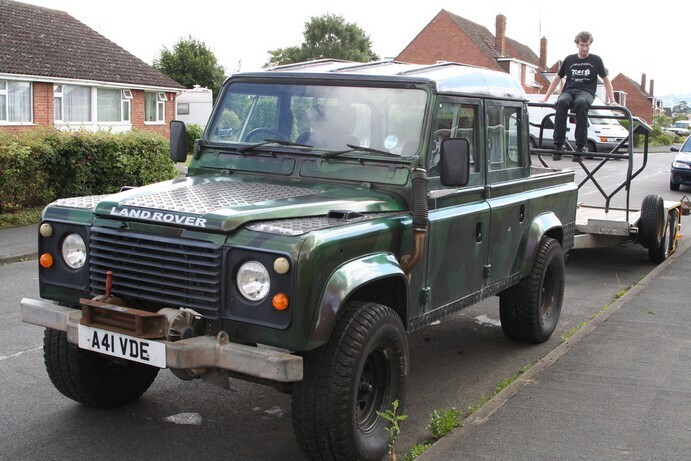 Stayed like this for a short while. And then I'd finally had enough of the wide wheels. They looked good but awful to drive with. Heavier steering with more limited lock. But the big problem was tram lining. Especially on motorways they would drop in to the grooves left by trucks. One of the military surplus dealers was selling off very lightly worn 7.50 Michelin tyres on wheels for a good price. Bought a set and fitted them, selling off the old wheels & tyres for more than the new ones cost. At the same time we added a spare wheel holder to the rear swing tailgate. Plus we made up a plywood hinged cover for the rear load bed. Ideal for carrying the camping gear when we did steam rallies. 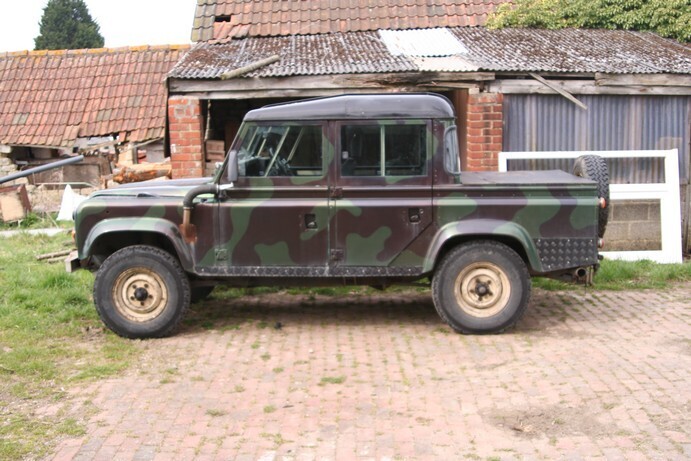 It doesn't look as good with these changes but they did make it a much more useable vehicle and a lot nicer to drive. Somewhere around this time we also stripped out the front seats. Replaced with proper defender front seats. The big advantage of this was the seat base is easily removed. Important on Landrovers as there is a storage compartment under the drivers seat and the battery under the passenger seat. With the bucket seats fitted we had to unbolt the seat each time we needed to get to the battery! Final big change was removing the double cab roof and changing to a full length county roof. The double cab roof had been badly modified and leaked. As well as the rear bulkhead having issues. I did look for a proper double cab roof and rear bulkhead but they were either too far away or too much money. The full length roof we found instead is unusual as it is a safari roof - double skinned. Landrover never did this for a 110 only for the earlier Series 2 & 3's. My parents had a 109 station wagon with safari roof when we were growing up. I was always impressed with how cool the inside of the vehicle stays when parked in hot sun. No sticking to seats when you get into it. Plus there are four vents in the roof that keep the inside of the vehicle cool when moving. An idea that really should make a come back. Would help reduce air con loads on electric vehicles and increase range...... Anyway that's the reason for wanting a safari roof. But back to the fact that Landrover never made one for a 110. This one has been made up by a previous owner using a 110 roof and then adding the top panel and vents from a 109 roof. This means that the top panel is an inch or so short. And a lot of fun must have been had drilling all the holes for the spacers to go between the two roofs. Plus cutting for the vents and then modifying the roof lining to suit. Photo below is how it looks with roof fitted along with the rear window panels and a rear door. I will do another post on us fitting the roof. 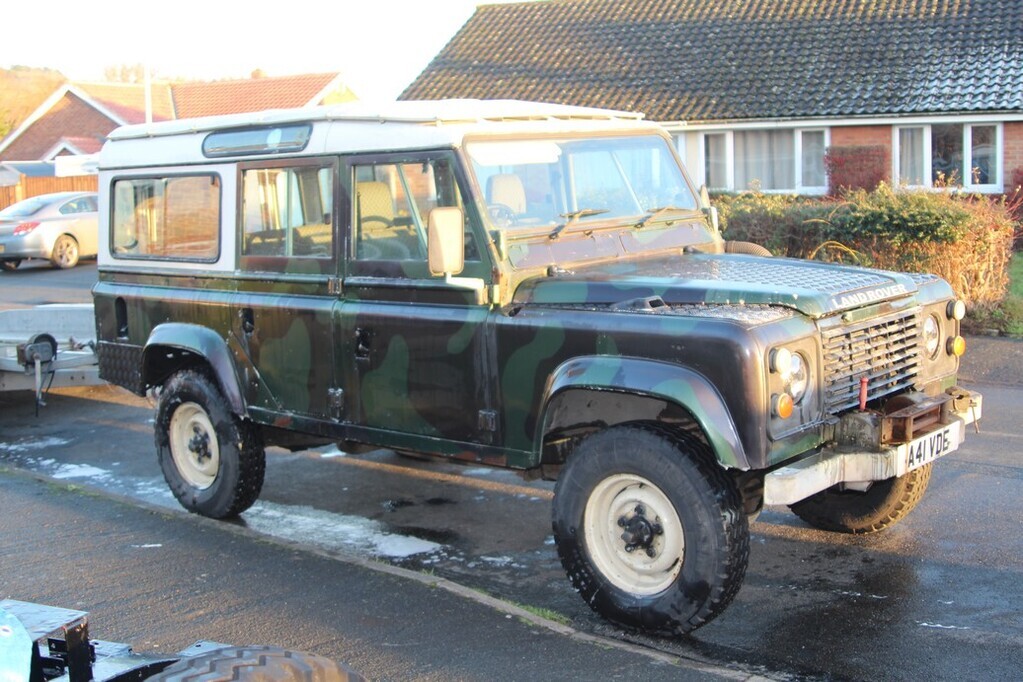 After the roof was fitted we also fitted progressively wound rear springs to finally bring it back up to a sensible height. It had got a bit hair raising on the shortened rear springs when we were carrying heavy loads. Not enough to be unsafe but definitely enough to concern passengers. We also fitted tubular front shock towers as I've never liked the normal landrover ones. Perfectly designed to trap mud around the front shocks. Whilst the suspension was in pieces we fitted galvanised springs seats and other hardware. Always advisable on Landrovers to replace with galvanised parts whenever you have to change bits. |
| |
Mine: 1938 Scammell Pioneer R100, 1944 Scammell Pioneer SV2/S, 1959 Kraz 255b tractor unit, 1960 Unipower Industrial ballast tractor, 1960 88 Landrover Series 2 SWB, 1983 110 Landrover CSW
Look after:
1935 Scammell Rigid 6, 1951 Scammell Scarab, 1961 Landrover Prototype, 1985 Landrover 110
|
|
|
|
|
Mar 27, 2021 11:09:21 GMT
|
|
Love the landies; I can hardly keep up with all the projects you have or are involved with!
Daan
|
| |
|
|
raumer
Part of things
 
Posts: 138 
|
|
Mar 27, 2021 12:43:13 GMT
|
The problem is neither can I! And I am very impressed with your Series 3. I've followed your adventures on LR4x4 with Ladoga & Croatia Trophy. Superb efforts and way beyond anything I'd do.  |
| |
Last Edit: Mar 27, 2021 12:48:18 GMT by raumer
Mine: 1938 Scammell Pioneer R100, 1944 Scammell Pioneer SV2/S, 1959 Kraz 255b tractor unit, 1960 Unipower Industrial ballast tractor, 1960 88 Landrover Series 2 SWB, 1983 110 Landrover CSW
Look after:
1935 Scammell Rigid 6, 1951 Scammell Scarab, 1961 Landrover Prototype, 1985 Landrover 110
|
|
|
|
|
Mar 27, 2021 16:04:13 GMT
|
The problem is neither can I! And I am very impressed with your Series 3. I've followed your adventures on LR4x4 with Ladoga & Croatia Trophy. Superb efforts and way beyond anything I'd do.  Cheers, Hadn't realized you were on Lr4x4. Daan |
| |
|
|
|
|
|
|
|
The problem is neither can I! And I am very impressed with your Series 3. I've followed your adventures on LR4x4 with Ladoga & Croatia Trophy. Superb efforts and way beyond anything I'd do.  Cheers, Hadn't realized you were on Lr4x4. Daan I wasn't aware of Lr4X4 either. Now enrolled. Thank you. |
| |
|
|
raumer
Part of things
 
Posts: 138 
|
|
Mar 28, 2021 14:22:14 GMT
|
|
By far and away the best Landrover forum I have found for technical advice. Especially when it comes to oddballs like my 110 that isn't the same as later ones. And some truly mad off road machines built. If you like extreme off roaders it's worth finding the build threads for Mouse, although I think most of the photos have disappeared. I tend to lurk in the background.
|
| |
Mine: 1938 Scammell Pioneer R100, 1944 Scammell Pioneer SV2/S, 1959 Kraz 255b tractor unit, 1960 Unipower Industrial ballast tractor, 1960 88 Landrover Series 2 SWB, 1983 110 Landrover CSW
Look after:
1935 Scammell Rigid 6, 1951 Scammell Scarab, 1961 Landrover Prototype, 1985 Landrover 110
|
|
|
|
|
Mar 28, 2021 21:00:25 GMT
|
|
I think I must be getting old... that 110 looks lovely with the cream roof and cream steel wheels. My younger self would be bolting the roll cage back on!
A blow over in blue or red and some 'County' stripes would have that looking lovely. Some good friends growing up had a C reg 12 seater as a family wagon from new, it was a 2.5 td and broke down a lot. I have fond memories of it though and can't remember the last time I saw one.
|
| |
|
|
hopeso
Part of things
 
Posts: 349 
|
|
Mar 28, 2021 23:26:09 GMT
|
|
I ran for some years a Stage One V8 109. What a vehicle once the restrictors were taken out of the carbs. Went like curse word off a shovel but drank fuel like a fish.
Wish I had it now!
|
| |
|
|
raumer
Part of things
 
Posts: 138 
|
|
Mar 30, 2021 16:53:02 GMT
|
The subject of colour will come up later. There is a plan, with a very long time frame!  Needless to say I've seen a couple of 110 county's in their original colours and they do look good. So on to the roof and rear body change. For anyone who hasn't played with or been around Landrovers they are just giant meccano kits. With lots of options on how you build them. In this case a fairly straightforward change from double cab to county. First photo with the chequer plate removed from the rear body and rear tailgate removed. Plus the new roof and body bits around it. We did have to order in the fitting kit for the roof and side panels, a combination of studs, rubber bushes, small brackets and nuts. Plus lots of nuts & bolts to hold the roof to the pillars, windscreen surround and rear panels.  Second photo with the roof removed and the cab back undone. 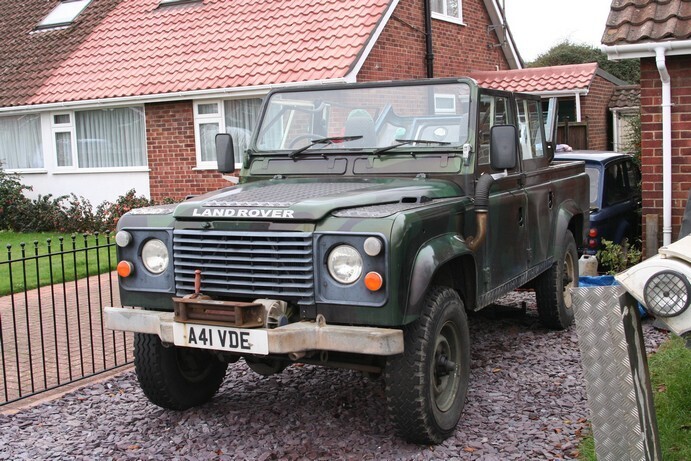 Third photo is the same state but from the back. You can see here the home made rear bulk head panel. The other side had angle iron glued and tacked in place. It never did seal properly.  Fourth photo now with the the rear side panels fitted. It was just after this that I arrived home from work. My girlfriend had done all of the work up to this point by herself. Only stopping because the roof is too big and awkward to be moved by one person. 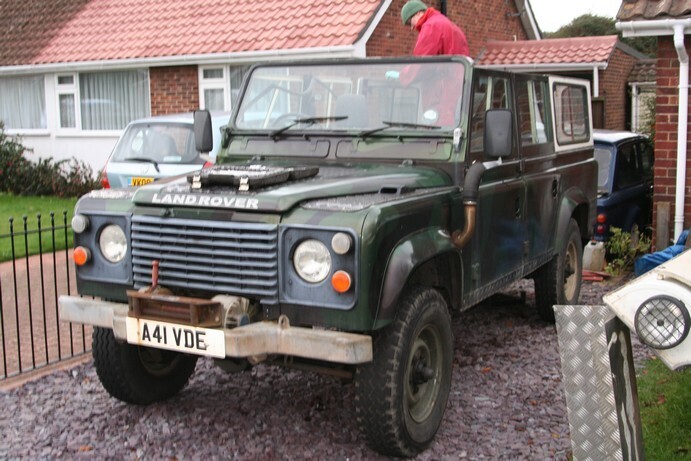 Fifth photo, roof now fitted and one happy girlfriend sat on the bonnet. 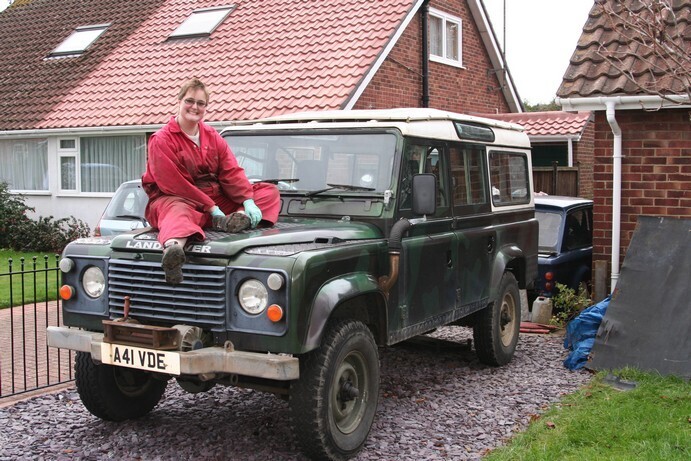 Final photo is of the inside of the roof. You can see wooden blocks fitted around the vents. This gives something for the roof lining to attach to. We have now fitted the roof lining but no photos. 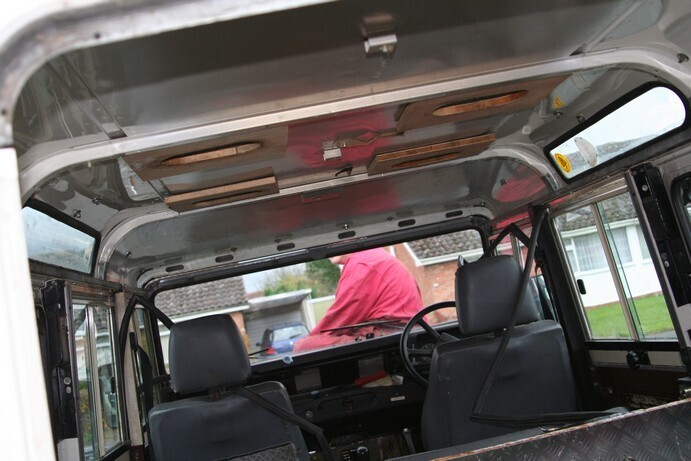 A fun job but fairly straightforward. Bar the nuts & bolts in awkward places that you come to expect. |
| |
Mine: 1938 Scammell Pioneer R100, 1944 Scammell Pioneer SV2/S, 1959 Kraz 255b tractor unit, 1960 Unipower Industrial ballast tractor, 1960 88 Landrover Series 2 SWB, 1983 110 Landrover CSW
Look after:
1935 Scammell Rigid 6, 1951 Scammell Scarab, 1961 Landrover Prototype, 1985 Landrover 110
|
|
|
|




























